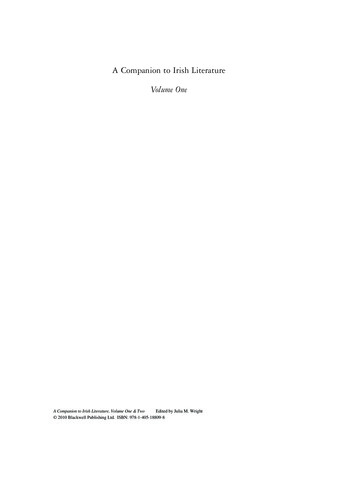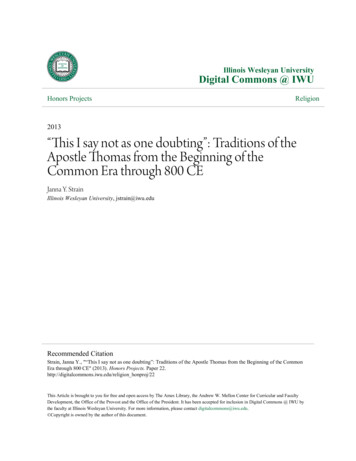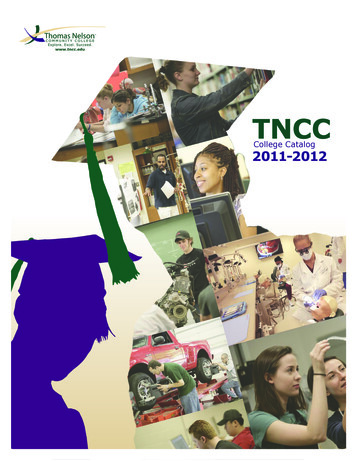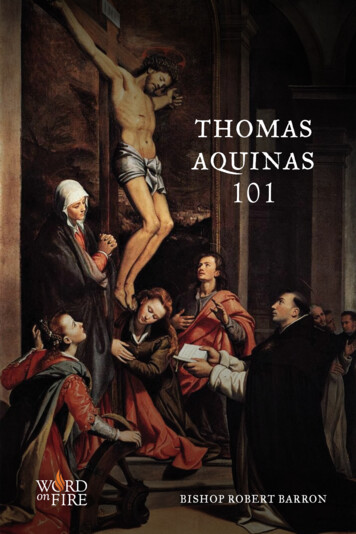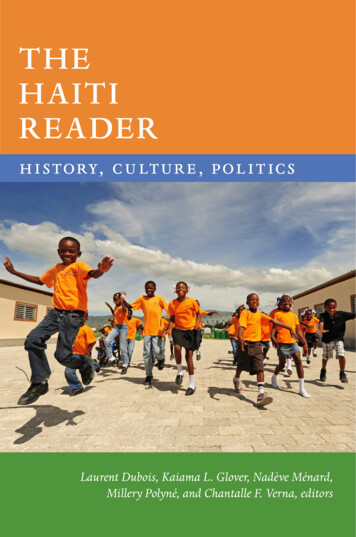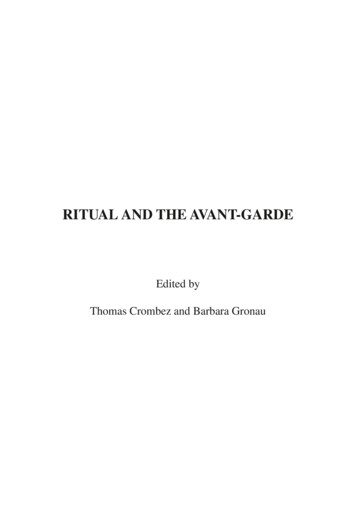
Transcription
RITUAL AND THE AVANT-GARDEEdited byThomas Crombez and Barbara Gronau
DOCUMENTAJAARGANG XXVIII (2010)NUMMER 1INHOUDThomas CROMBEZ & Barbara GRONAU:Ritual and the Avant-Garde: Introduction .5Thomas CROMBEZ: Avant-Garde Heritage: Three concepts ofritualism for the performing arts .8Günter BERGHAUS: Artaud's Le Jet de sang:An unperformable Surrealist play? .21Luk VAN DEN DRIES: Artaud and Fabre .36Barbara GRONAU: “I Did Take the Role of the Shaman ”The artistic rituals of Joseph Beuys .48Mario BÜHRMANN & Heiner REMMERT: Hermann Nitsch andthe Theory of the “Orgies Mysteries Theatre” .59Kaftontwerp: Etienne Hublau
4DOCUMENTATIECENTRUM VOOR DRAMATISCHE KUNST V.Z.W.RAAD VAN BESTUURJozef De Vos (voorzitter), Freddy Van Besien (ondervoorzitter), Dirk Willems(secretaris), Jan Hoeckman (penningmeester).REDACTIE DOCUMENTAJozef De Vos (hoofdredacteur), Luc Lamberechts, Annick Poppe,Freddy Decreus, Ton Hoenselaars, Jürgen Pieters, Mieke Kolk, Johan Callens,Yvonne Peiren, Johan Thielemans, Karen Vandevelde, Christel Stalpaert, Ilka Saal.***DOCUMENTA is een driemaandelijks tijdschrift van het Documentatiecentrum voor Dramatische Kunst, v.z.w. en het Documentatiecentrum voorDramatische Kunst, Universiteit Gent.Bijdragen, boeken ter recensie, bibliografische informatie en alle redactionele correspondentie dienen te worden gericht aan Dr. Jozef De Vos,Documentatiecentrum voor Dramatische Kunst, Universiteit Gent, Rozier 44,9000 Gent.Alle correspondentie betreffende abonnementen, betalingen, enz. dientte worden gericht aan de heer Jan Hoeckman, Bromeliastraat 28, 9040 Gent(Sint-Amandsberg).Een jaarabonnement kost E20 (België) of E30 (Nederland) te storten oprekening 447-0069151-12 van het Documentatiecentrum voor Dramatische Kunst,Gent.Voor betalingen vanuit het buitenland gelden volgende code en nummer:SWIFT: KREDBEBBIBAN: BE 1944700691 5112Losse nummers zijn verkrijgbaar tegen E7.ISSN 0771-8640
5RITUAL AND THE AVANT-GARDE: INTRODUCTIONThomas CROMBEZ & Barbara GRONAUSince the heyday of the post-war avant-garde has passed, the vocabulary ofritualism has entered into mainstream theatre. Is it a coincidence that two European directors, who were once considered part of the avant-garde, have recentlypenetrated the ‘citadels’ of traditional theatre, and moreover did so with ritualisticproductions in a pseudo-medieval garb? In the summer of 2001, Jan Fabre wasinvited to let the dancer-knights of Je suis sang mount the stage in the imposingfortress of the Palais des Papes at Avignon. In November 2005, Hermann Nitschbrought the blindfolded, crucified and naked actors of his Orgies Mysteries Theatre into the Burgtheater, the very stronghold of the Austrian bourgois establishment he had fought for decades.Has ritualistic art degraded into kitsch, as the armoured knights and sacrificialvirgins of Fabre and Nitsch suggest? Or has the ritualist vocabulary now simplybecome an integral part of the rich, ‘postdramatic’ theatrical language that contemporary artists can employ?Indeed, many directors are integrating elements from the ritualistic ‘tradition’into their work. By opting for a physical acting style influenced by performanceand body art, for a visual dramaturgy, and for a strongly symbolical, often dreamlike scenographic compositions—instead of textual dramaturgy and realistic acting and scenography—a coherent body of theatrical work has established itselfsince the 1980s. Hans-Thies Lehmann adequately described it in his seminal workPostdramatic Theatre (1999). Directors such as Robert Wilson, Tadeusz Kantor,Einar Schleef, Klaus Michaël Grüber, Jan Fabre, Romeo Castellucci, ChristophMarthaler, and Jan Lauwers have re-established the relevance of a certain ‘ritualistic quality’ of theatrical art. In these productions, the performers’ bodies, actionsand words are immersed in a rarefied atmosphere that feels related to the verymedium of religious ritual.From the end of the nineteenth century onwards, the avant-gardes introduced therelevance of ritual to modern art. Before we may gauge the precise value of today’sritualism, the ritualistic ‘tradition’ of the avant-garde therefore deserves our attention.The interest for rituals at the end of the nineteenth century is motivated by thefundamental crisis that European culture confronts. While the basic concepts of
6modernity—such as perception, representation, and subjectivity—are devaluated,the recourse to pagan motives and ritualistic practices seem to promise a forgottenholistic approach. Whether they take the form of ancient tradition or exotic folklore, rituals seem to provide a fascinating outlook on something beyond the logosof the modern bourgeois individual. Therefore it is hardly surprising that FriedrichNietzsche’s Die Geburt der Tragödie from 1871 draws an image of redemption bylinking the Greek cult of Dionysus to the music of Richard Wagner. One can takeNietzsche’s text as the initial spark of a discourse that emphasizes that not onlythe arts, but also culture in general, have to recover their transgressive potential bytaking up their ritualistic roots.With James Frazer’s The Golden Bough (1890), Arnold van Gennep’s Les Ritesde passage (1909), and Emile Durkheim’s Les Formes élémentaires de la vie religieuse (1912), rituals are also at the centre of the upcoming discipline of ethnology. As much as the scientific view on rituals produced a variety of definitions,the artistic avant-garde never seemed to have a clear concept of ritual, but insteadtakes the term as some kind of ‘discursive void’—an open source for imaginations,materials, and practices. As well as increasingly rhythmic dance-movements (suchas in Igor Strawinsky’s Le sacre du printemps from 1913) there appeared repetitive patterns of sound or language (for example, in the dadaist performances) anda specific kind of costumes, light effects, and set design which were part of theartistic re-ritualization.Although many prominent artists of the historical avant-garde were highlyfascinated by the artistic potential of rituals (amongst which Oskar Kokoschka,Oskar Schlemmer, the Futurist theatre designers, and many artists from Surrealism) it is Antonin Artaud who has become known as the pre-eminent advocate ofritual. For Artaud, a ‘physical’ language for the theatre, inspired by Eastern formsof performance such as the Cambodian and Balinese dance theatre, would beable to rediscover the therapeutical efficacy of theatrical events, and by doing soremedy the grave crisis of modernity made evident in the wake of the First WorldWar.In the first essay Thomas Crombez examines how Artaud’s preconceptionshave shaped the conceptions of ritual that were developed mainly after the SecondWorld War. For many post-war intellectuals and artists, ‘Artaud’—or rather, theemblematic image of the insane and suffering Artaud—became paradigmatic for anew conception of theatre and counterculture. Post-war society in Europe and theUS was highly in need of figures like Artaud, who symbolized the most extremeand subversive attitude in regard to social structure and conventional art. As is
7evidenced by the many re-editions and translations of his writings from the fiftiesonwards, Artaud became a contemporary during the first decades after the Second World War. This cultural ‘need’ has profoundly influenced our contemporaryidea of ritualism in the theatre. However, Crombez also tries to show what otherconceptions of ritual have been possible since the First World War, but were notsuccessful in establishing themselves.Two subsequent articles further explore the ritualistic heritage of Artaud.Günter Berghaus undertakes a practice-based re-examination of Artaud’s outstanding surrealist play Le Jet de sang (1925), and finds his ritualistic interestexpressed through a whole range of exasperating theatrical innovations. Luk Vanden Dries shows how the obvious ‘ritualistic’ interpretation of Jan Fabre’s workin the light of Artaud may be avoided. He rather tries to chart the other meetingpoints between the oeuvre of Fabre and that of Artaud: the topos of pain, personalcruelty, the affective athleticism of performers, and the search for an alternativestage language of signs and icons.We return to a more historically oriented analysis of ritualism with the articleof Barbara Gronau on the ‘secular rituals’ of post-war performance artist JosephBeuys. Still, Beuys’ work simultaneously demonstrates a strong fascination withthe properly religious content of ritual. It is no accident that his ‘secular rituals’were full of references to iconical gestures and rites from the Christian tradition.What the essays collected here most clearly show, is that the fascination with thesocial potential of rituals was nearly always connected to a certain ‘religious’ tendency—even if the relation of these artists to established religion was often problematic.This collection of essays closes with a contemporary case study of preciselythis anthropological and religious problematic. Mario Bührmann and Heiner Remmert study the writings and recent performances of the Austrian AktionskünstlerHermann Nitsch, asking if ritualism has indeed, after a long and fruitful careerthroughout twentieth century theatre, degraded into kitsch.***This collection of essays, edited by Thomas Crombez and Barbara Gronauresulted from the workshop on “Ritual, Theatre, Community” held at the University of Antwerp (5 May 2007). The workshop was co-funded by a researchgrant from the Antwerp University Association and a conference grant from FWOVlaanderen (Research Foundation – Flanders).
8AVANT-GARDE HERITAGE: THREE CONCEPTS OFRITUALISM FOR THE PERFORMING ARTSThomas CROMBEZAbstractWhat exactly do we mean when, in the contemporary performing arts, the wordritual is pronounced? I argue that, although one main concept of theatrical ritualism is currently activated, the history of twentieth-century theatre offers atleast two alternative notions that were less succesful at establishing themselves.The dominant notion may be termed ‘hot’ ritual, and is chiefly inspired by thewritings of Antonin Artaud. The first alternative notion will be termed ‘minimalist’ ritual (strongly related to the Fluxus movement and happening art), the second ‘liturgical.’ Conspicuously, the theatrical-liturgical efforts of the interbellumperiod transmitted no legacy to post-war European theatre.In his essay from 1974, ‘From Ritual to Theatre and Back,’ Richard Schechnerattempted to explain what crucial aspects of ritual had made it so attractive to theavant-garde artists of the twentieth century. Schechner identified ‘efficacy’ as thedefining characteristic of ritual, in contrast to theatre—either the sacred efficacyof religious ritual, remediating the community’s relationship to the divine, or thesocial efficacy of rituals such as wedding ceremonies or rites of passage, thatchange the social status of some of its participants.But after generations of avant-garde artists have attempted to rediscover thisfabled ‘efficacy’ in the most various ways, the question may be posed whetherritualism is still a credible alternative for the continued reinvention of Westerntheatre. High-profile productions such as Jan Fabre’s Je suis sang at the Festivald’Avignon (2001), or the 122nd Action by Hermann Nitsch at the famous Burgtheater in Vienna (2005), throw doubt on the conception of ritualistic theatre asa critical instrument to expose the hidden or repressed truths of Western society.Ritualism—the artistic mise-en-scène of rituals—rather seems to have become anintegral part of the society of spectacle. In the caustic phrasing of Roland Barthes:‘L’avant-garde n’est jamais qu’une façon de chanter la mort bourgeoise, car sapropre mort appartient encore à la bourgeoisie ’1
9With Fabre and Nitsch, the bourgeois swan song has turned into the deathrattle of armoured knights and sacrificial virgins. The critical attitude, already institutionalized, now lapses into ritualistic kitsch. But kitsch cannot appear as suchwithout being related to a widespread cliché. These two directors merely makemanifest that ‘ritualism’ itself is a problematic category. What exactly do we conceive when, in the contemporary performing arts, the word ritual is pronounced?I will argue that there is one main concept of theatrical ritualism currently activated, and that there are at least two viable alternative notions to be found in thehistory of twentieth-century theatre and theatrical theory. The dominant notionmay be termed ‘hot’ ritual (on the analogy of classical sociological theories onthe role of effervescent ceremonies in the genesis of morality—e.g., in the work ofEmile Durkheim2). The first alternative notion will be termed ‘minimalist’ ritual,the second ‘liturgical.’The hot concept of ritual is based on certain ideas of the historical avantgarde, as they were interpreted and put into practice by the post-war (or ‘neo-’)avant-garde. This historical detour subsequently weighted the original, pre-wartheories. ‘Hot ritual’ was inspired (at least partially) by the writings of AntoninArtaud, but, from the 1960s on, he was invariably read through the lens of a certain body of post-war performances. This thread of ritualism includes so-called‘physical theatre’ by groups such as the Living Theatre, The Performance Group,Grotowski’s Laboratory Theatre, and the numerous international disciples of thePolish director’s workshops. It was reinforced by the simultaneous emergence ofbody art and performance art, practiced by Yves Klein, Yoko Ono, Otto Muehl,Hermann Nitsch, Marina Abramovic, Carolee Schneemann, and many others.However, other trends in music and visual arts led to a second and differentunderstanding of ritual. This ritualistic current, which I dub ‘minimalist,’ originated in the sphere of Fluxus. Artists such as (in the US) John Cage, Merce Cunningham, Allan Kaprow, George Maciunas, and (in Europe) Joseph Beuys, BenVautier, and Marcel Broodthaers moved towards a conception of ritualistic eventsfar less related to eruptive, pseudo-Dionysiac gatherings. Rather, these ‘untitledevents’ and happenings were based on chance phenomena, objets trouvés, improvised materials, humor, and—certainly in Kaprow’s case—a certain ‘quiet’quality often described as related to meditation and Buddhist ceremony. I wish toexamine this particular quality further by means of the theoretical works of theFrench sociologist and philosopher Georges Bataille. Admittedly, Bataille seemsat first sight more connected to the ‘hot’ concept of ritual, although I will arguethat he ultimately came closest to the minimalist notion.
10First issue of Acéphale (June 1936), the literary and philosophical journalfounded by Georges Bataille
11A third conception of ritual was even less prominent, and did not manage tolast until the present day. This conception was introduced by modernist productions from the interwar period based on Catholic liturgy. Throughout my exploration of the alternative concepts of ritualism, the guiding question will be: whydoes ‘ritual’ in the performing arts today look the way we expect it to look?Antonin Artaud’s Theory of CatharsisAs a starting point for describing the presence of ritualism in the writings ofAntonin Artaud, one cannot overlook his most explicit socio-theatrical concept,namely, that of collective purification. It is a topos in Artaud studies that the theory of the Theatre of Cruelty also encompasses a cathartic doctrine.3 The necessityto reflect on social healing stems from the diagnosis of the apocalyptic culturalphilosopher Artaud that Western culture is being eroded by a ‘crisis.’ Expressed inthe most extreme terms: ‘nous sommes tous fous, désespérés et malades.’4 In thatregard Artaud’s opinions are positioned within the framework of popular occultism and a fascination for Eastern philosophy.In ‘Le Théâtre et la Culture,’ the essay that introduces Le Théâtre et sonDouble (1938) as an ominous prelude, this crisis is alluded to the least vaguely.A schism between ‘life’ and ‘culture’ results in a certain quantum of negative butvital energy, which no longer finds a safety valve via culture, but is expressedin perverse felonies, earthquakes, volcanic eruptions, and train disasters.5 AsGoodall remarked, Artaud’s cathartic solution for that problem is to be found inkeeping with Paracelsic homeopathy, which was provided to him by Dr. RenéAllendy.6 Evil must be conquered by its equal, in this case by a theatrical reinforcement factor: ‘le théâtre est fait pour vider collectivement des abcès.’7 Theintensity of the theatrical happening fuses actor and spectator together into an association which allows the negative energy to course through in a therapeuticallyeffective way.Artaud attached great importance to mass theatre. He undertook various attempts to organize such a spectacle.8 Consequently, the collective aspect of Artaudian catharsis must be underlined. The emphasis is predominantly on the theatreas a means of mutual purification, and even socio-political pacification. In someareas Artaud confesses to an extremely naive belief in a violent theatre as a deterrent for the masses: ‘je défie bien un spectateur à qui des scènes violentes auront passé leur sang ( ) de se livrer au dehors à des idées de guerre, d’émeute etd’assassinat hasardeux.’9 Artaud confesses to an idealistic doctrine regarding the
12Troubleyn/Jan Fabre, Je suis sang (conte de fées médiéval) (2001).Performers: Heike Langsdorf, Cedric Charron, Ivana Jozic(amongst others). Photo by Wonge Bergmannoperation of the theatre, entirely according to the ‘heilsame Schauer’ that, according to Friedrich Schiller, would make a deep impression on the audience.10The predominant image of Artaud’s ideas was greatly influenced by the waythey were disseminated after his death in 1948. An ‘Artaud myth’ developed thatread his pre-war writings through the lens of the final years.11 Artaud became thearchetypical nemesis of social order as such. In his ravaged body was inscribedthe demand to liberate the individual from the constraints that the social systemhad installed. Especially his long psychiatric internment influenced this readingof his life and works, together with the much-publicized events of his return topublic life between 1945 and 1948, such as the excruciating ‘performance’ at theThéâtre du Vieux-Colombier, Histoire Vécue D’ARTAUD-MOMO (13 January1947).The Artaud myth easily fitted in with the neo-avant-garde performing arts developing after the Second World War. Post-war counterculture had many interestsin common with Artaud. It explored occultism and believed that dreams, narcot-
13ics, and spontaneous and accidental activities should inspire the arts. Artaud’sstrong criticism of Western society was responsible for the principal attractionof his work for theatre reformers like Jerzy Grotowski, Peter Brook, Julian Beckand Judith Malina.12 This in turn fostered the hypothesis that post-war ritualistic performance was the true realization of Artaud’s original theories. Ritualismgradually became understood as the need for therapeutic, collective theatricalevents that smashed the existing social order and replaced it with an authentic andintense, if short-lived, experience of communitas.13 Thus, the Artaudian notionof social crisis and purification, realized (in a certain way) through the post-waremergence of physical and environmental theatre, provided the basis for a ‘hot’concept of ritual in the performing arts.The Minimalist Fluxus Concept of RitualWhen contrasted with the ritualized and primitivist happenings from postwar theatre, most events organized by Fluxus artists seem rather light-headed andfrivolous. John Cage himself advocated a kind of theatre that would be indistinguishable from normal life: ‘[T]he reason I want to make my definition of theaterthat simple is so one could view everyday life itself as theater.’14 The essence ofthe theatrical is to be found in the eye of the beholder, an ideal Fluxus spectactor,or ‘everyday life artist.’In this regard, the abundant ‘scores’ for minimalist happenings that Allan Kaprow produced, may be considered to constitute a second, if minor, paradigm forritualism. Consider, for example, the score of Taking a shoe for a walk (undated):Pulling a shoe on a string through the cityexamining the shoe from time to time, to see if it’s worn outwrapping your own shoe, after each examination, with layers of bandage or tape,in the amount you think the shoe on a string is worn outrepeating, adding to your shoe more layers of bandage or tape, until, at the end ofthe day, the shoe you are pulling appears completely worn out15Taking a shoe for a walk might be labelled subversive, because its performerwill, in an ordinary town or city, probably be frowned upon by passers-by. Hemight even be considered a tramp and treated accordingly. Yet its main theme isnot a critique or commentary on public life. It is precisely everyday life itself, orrather, the isolated and slightly queer, but ultimately rather harmless and insignificant action itself. To act out Taking a shoe for a walk means literally nothing more
14but to execute the described steps, regardless of the context of the performance,nor of the attitude the performer takes towards it—either in a concentrated andcontemplative way, or merely bored and tired, or compelled to do it by someoneelse. The score stipulates the details of an action that is purely self-referential. Itmight very well invite the actor to reconsider his life and discover a fundamentalwisdom in the process. But it might just as well not.No theoretical ancestor or ‘mastermind’ is equally strongly connected to theFluxus events, as Artaud was to the pseudo-Dionysiac spectacles. Certainly Dadawould qualify, albeit primarily on a practical level. Dadaists (and also, to a certaindegree, Situationists) strove to transform the chance happenings and idiosyncrasies of everyday life into art. But they did not provide an elaborate theoreticalframework for those attempts. However, there is a surprising degree of correspondence between Fluxus events and the writings of Georges Bataille.In Bataille’s articles of the late 1930s for the Acéphale journal, and in theevents he organized with the eponymous ‘secret society,’ a concept of ritual appears that fits Fluxus surprisingly well. At first sight, however, Bataille’s startingpoint is similar (almost verbatim) to that of Artaud. The Acéphale project, Bataillenotes in the first issue, ‘ne peut pas être limité à l’expression d’une pensée et encore moins à ce qui est justement considéré comme art.’16 It is rather to be compared to a kind of political agitation, animated by the same force of nature thatdrives us to producing and consuming food. In the same vein, Artaud commenceshis reflections on culture with the derogatory remark that: ‘Avant d’en revenir à laculture je considère que le monde a faim, et qu’il ne se soucie pas de la culture.’17It follows (at least in Artaud’s mind) that, once human hunger is stilled, it ought tobe the residue of hunger that drives humans towards culture, not some lofty andself-sufficient ideal.Equally similar is their apocalyptic diagnosis of the total crisis engulfing Western society. It is only concerning the proposed remedies that Bataille starts to differ from Artaud’s opinions, although this is only manifest from the Acéphale textsonwards. Earlier in the 1930s, the anti-fascist group Contre-Attaque—in whichnot only Bataille, but also André Breton and many diverse intellectuals from theleft were involved—had called for a revolutionary uprising. The masses wouldconquer the streets, driven by ‘l’émotion soulevée directement par des événementsfrappants.’18 This sounds highly similar to Artaud’s description of the public agitation accompanying a police raid on a brothel, which he described as ‘the idealtheatre.’19
15In 1937, however, Contre-Attaque had stranded, and Bataille’s search for anevent that would embody the sacral in modern society turned inwards. In his theoretical essays from the early 1930s, the sociologist Bataille had studied the phenomenon of ‘dépense pure’ (pure expenditure).20 The concept he derived fromnon-Western social ceremonies, such as the potlatch of certain Native Americantribes (reciprocal gift-giving in which wealth is redistributed or sometimes destroyed, bestowing a higher social status on the giver). Such festivals were a primeexample of a wider category of social phenomena he dubbed ‘the heterogeneous.’ It also included eroticism, waste, religious sacrifice, art works, and generallyspeaking all sorts of expenditure that did not contribute to rational and economically productive goals.It was phenomena of unproductive expenditure, Bataille believed, that madehuman community truly possible. Their disappearance in over-rationalized Western societies had also hastened the disintegration of the social fabric. Parallelto the Acéphale journal, a ‘secret society’ also called Acéphale was founded torekindle events of pure expenditure. It remains unclear what events Bataille precisely scheduled for the members of the group. Even taking into account the documents disclosed by Marina Galletti,21 the following description by Botting andWilson can hardly be augmented:Particularly interested in sacrifice, the group met in secret and in locations like thePlace de la Concorde, where Louis XVI was executed. They also met in ominousplaces deep in the woods where plans were made for a human sacrifice, an act ofcriminal violence that would bind the group together in shared guilt.22In any case, Bataille conceived the happenings as pure ‘play,’ according tothe definition that Johan Huizinga would give around the same time in his bookHomo Ludens (published in Dutch in 1938). ‘If we consider it in the perspectiveof a world determined by forces and their effects, it is a superabundans in the fullmeaning of the word, something that is superfluous.’23 Especially (religious) sacrifice appealed to Bataille, as the perfect example of a sacred act that was whollyisolated from the world of reason and economic production, i.e., an act of totalfreedom. ‘Si elle n’est pas libre, l’existence devient vide ou neutre et, si elle estlibre, elle est un jeu.’24 In this regard Bataille’s vision is quite different from thatof Artaud. His theory of ritualist theatre was clearly aimed toward collective purification. That of Bataille, on the contrary, aspired to wholly self-contained acts ofpure expenditure. His scripts for the Acéphale happenings strictly stipulated whatwas to happen, but it never turned into a spectacle, nor was there an audience.
16Troubleyn/Jan Fabre, Je suis sang (conte de fées médiéval) (2001).Performers: Ivana Jozic, Katrien Bruyneel, Anny Czupper.Photo by Wonge Bergmann
17Catholic Liturgy and Modernist TheatreDuring his activities with the Surrealist movement in the 1920s, Artaud coedited an issue of La Révolution Surréaliste entitled ‘Fin de l’ère chrétienne.’ Bataille’s Acéphale was to be a religious community, and even ‘savagely religious,’but only ‘in a violently anti-christian sense.’25 Both models for contemporary ritualism that I have discussed were based on anti-Christian ideas. But the interwarperiod also saw diverse theatrical reformers advocate the need for a return toChristianity. T.S. Eliot stated, in ‘A Dialogue on Dramatic Poetry’ (1928), that:‘The only dramatic satisfaction that I find now is in a High Mass well performed’(Eliot 1972: 47). In the same vein, the French dramatist Paul Claudel’s artisticconclusion was to introduce liturgical elements in the texture of his plays. In LeMasque et l’encensoir (1921), Gaston Baty developed a similar intuition into a historical essay on the origins of theatre. Religious ceremony, and most importantly,medieval Catholic liturgy, was the true dramatic phenomenon, because it had integrated all dramatic components—the spoken text and the non-verbal elementsof spectacle—into a harmonious whole.26Catholic liturgy, however, also posed a tremendous problem to modernist theatre practitioners. Convinced that theatre should break out of the autonomy of art,and approach the efficacy of ritual, it was unclear how this efficacy was to beunderstood or realized. However great their admiration, few modernists went sofar as to strive for a genre truly in-between religious practice and modern drama.They tried to imbue the existing Western theatre with the powers of liturgy, butwere reluctant to demand the creation of a new dramatic genre that would trulyreinvent liturgy for the modern age. Others, however, unhesitatingly stated thatsuch a form could be developed. Its creators should be the ideologically organizedmasses of the interwar period.Mass theatre was a popular expression of ‘community art’ in most Europeancountries during the interbellum period. From Max Reinhardt’s lavish open-airspectacles (such as Everyman in Salzburg, 1920) to the Soviet restagings of theStorming of the Winter Palace in Leningrad, or the Socialist workers’ Laienspiel(lay theatre), theatre visionaries focused on ever larger groups for entertainment aswell as political agitation. Among Western European countries, Belgium was oneof the last to follow the new trend of socio-theatrical events. It was imported viathe Socialist movement from Germany and Russia, passing through the Netherlands where workers’ choirs (both singing and reciting choirs) had quickly risen infavour. In the case of Belgium, and Flanders in particular, it is especially interesting to note that the mass theatre phenomenon displayed an ideological heteroge-
18neity not seen elsewhere. Cathol
This collection of essays, edited by Thomas Crombez and Barbara Gronau resulted from the workshop on "Ritual, Theatre, Community" held at the Uni-versity of Antwerp (5 May 2007). The workshop was co-funded by a research grant from the Antwerp University Association and a conference grant from FWO-Vlaanderen (Research Foundation - Flanders).
